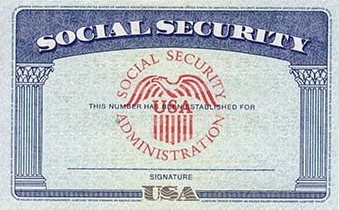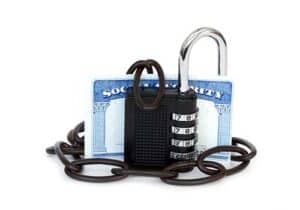Many vital documents in your life are already laminated or have a protective, glossy finish. Consider your driver’s license, Medicare card, credit card, or passport. These documents are more durable and sturdy than a simple piece of paper.
However, your Social Security card is printed on paper without any protection. So, you might be wondering whether you can laminate it to provide extra protection. This could help prevent it from damage like tears or stains.
But can you laminate your Social Security card, and is it even legal? Keep reading for all the details you need to know when considering lamination.
Can You Laminate A Social Security Card?
The short answer is yes; you can laminate a Social Security card. However, the Social Security Administration recommends against it. You will find that instruction on the SSA website and on the back of the card itself.
Security Features
The SSA instructs you not to laminate your card for several reasons. The biggest reason is that your card contains essential security features that can be lost once it is laminated. These include the anti-copy pattern on the card and the banknote paper on which it is produced. Once laminated, detecting these essential security features can be almost impossible.
Since your Social Security number and card are extremely important and confidential, you should not risk losing those security features.
Not Accepted
A laminated Social Security card might not be accepted as genuine when you attempt to use the card for identification purposes. Since counterfeiting is a big problem, you want to avoid anything that might call into question the authenticity of your card. This could be a problem when you start a new job and must present your card for identity verification. Your new employer might not consider a laminated card a valid form of identification, which could cause big problems.
KEY TAKEAWAYS
- Laminating your Social Security card is not illegal, but the SSA does not recommend it. It might ruin the card’s security features, and places may not accept it as valid.
- The best method for protecting your Social Security card is to use a plastic sleeve or case when carrying your card.
- When not being used, you should keep your Social Security card and other essential documents in a waterproof & fireproof safe or a safe deposit box at your bank.
Is It Illegal To Laminate A Social Security Card?
While it is not recommended, it is also not illegal to laminate your Social Security card. The Social Security office will not ask the police to come and arrest you if you have already laminated your card. The recommendation from the Social Security Administration is just that — a recommendation. No law prohibits you from laminating your card, and some people still choose to do it against the advice of the SSA.
You do not have to worry about criminal penalties if you have already laminated your card. However, you might decide to remove the lamination from the card. There are a few ways that you can do this, but using heat seems to produce the best results. It can be a tedious process, and you should perform the task delicately so that you do not damage your card. You might need to request a replacement Social Security card if you do.
Must read articles related to Social Security Cards
- What are the steps for getting a replacement Social Security card?
- How do I perform a Social Security name change in 3 easy steps?
- I recently moved and need to change my address with Social Security.
- Find out how much you can earn while on Social Security.
- I lost my Social Security card…what should I do?
Alternative Methods For Protecting Your Social Security Card
So, how can you protect your Social Security number and card if you can’t laminate it? There are many alternatives to protecting your card without lamination.
First, you should consider keeping the card in a safe place at home and not carrying it with you unless you need it for a specific reason. Carrying your card all the time only increases the odds that it will get lost, stolen, or damaged. When you need the card, like when you start a new job, you can carry it and return it to a safe place when you are done.
Plastic Sleeve
An excellent option for protecting your card when carrying it is to use a plastic sleeve. Simple baseball card sleeves can be purchased for a meager cost on Amazon and provide excellent protection for your card.
Plastic Case
A removable plastic case offers even more protection. You can slide your original card into the case, and the card can be easily removed and verified as an original document when the time comes. These plastic sleeves do not interfere with the copy-proof background or other security features designed to prevent scammers from copying Social Security cards and your SSN.
TIP
If you’ve already laminated your Social Security card, you don’t need to worry. The worst that may happen is that someplace may not accept it as a valid ID. You can always order a replacement Social Security card if necessary.
How To Protect All Your Important Documents
You likely have other essential documents besides just a Social Security card. This could be a birth certificate, passport, or one of many documents you might need to protect and store. While laminating documents can sometimes be an excellent way to protect them, most of these documents should not be laminated. Here are a few tips for protecting them.
First, make sure that you keep them in a safe and secure location. Ideally, this would be your home, as other locations, like a storage unit, could be more subject to theft or damage.
- You might also consider a safe deposit box at your local bank.
- A locked safe inside your home — preferably waterproof and fireproof.
Do not carry these essential documents with you all the time, as this increases the likelihood of losing one and becoming subject to identity theft. Only remove these documents from storage when necessary for identity verification or some other purpose.
The Bottom Line
Though it is not illegal to laminate your Social Security card, the Social Security Administration advises against it. By laminating the card, you risk ruining certain security features.
If laminated, your card could be considered a counterfeit when presented as identification. Instead, put your card in a plastic sleeve for protection and store it in a safe place when not in use.
Frequently Asked Questions
There is no standard thickness for a laminated Social Security card. The Social Security Administration recommends that you do not laminate your card. If you decide to do so anyway, then the thickness will depend on your specific lamination method.
If you lose your Social Security card, you might become subject to identity theft if it falls into the wrong hands. You should request a new card from the Social Security Administration to replace the lost card.
It would be best if you also kept a close eye on your credit report to catch any unauthorized activity immediately. You might even consider placing a fraud alert on your credit profile so that potential lenders take extra steps to verify your identity before issuing credit in your name.
No, your Social Security number does not change when you change your name. Most people will keep the same Social Security number for their entire life. The Social Security Administration will not typically issue a new Social Security number once you have been assigned one.
However, in severe cases of ID theft, you might be able to get a new SSN. If the theft is so bad that your credit record cannot be repaired, SSA will issue you a new SSN. However, this is limited to the most severe cases.
You can find a Social Security Administration office near you by using our SSA office locator and searching for your closest location.






